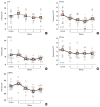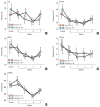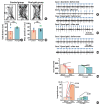Free gait in a shallow pool accelerates recovery after exercise in model mice with fibromyalgia
- PMID: 33178641
- PMCID: PMC7609855
- DOI: 10.12965/jer.2040672.336
Free gait in a shallow pool accelerates recovery after exercise in model mice with fibromyalgia
Abstract
This study aimed to determine the effect of pool gait exercise using fibromyalgia-induced model mice. The sensory threshold, locomotive behavior, electrocardiogram, and onset time after the gait test in shallow water using male C57BL/6J mice (weight, 30-35 g; n=21) were investigated. To induce fibromyalgia in model mice, reserpine was injected intraperitoneally into wild-type mice once a day for 3 days. Subsequently, the fibromyalgia-induced model mice were randomly classified into two groups as follows: the control group (n=11) and the pool gait group (n=10). The mice in the pool gait group walked in the same cage containing shallow warm water 5 times per week. Both groups underwent sensory thresholds and video recordings to determine locomotive behaviors weekly. Further, both heart rate and video recordings for observation of a recovery after the gait test in shallow water were undertaken (control group; n=5, pool gait group; n=5). The pool gait did not affect sensory thresholds and locomotive behavior; however, in the pool gait group, both the recovery after the test, such as onset time and gait distance, were considerably better than those of the control group. Furthermore, changes in heart rate and heart rate irregularity after the test were more apparent in the control group than in the pool gait group. The free gait in a shallow pool accelerated recovery after exercise, unlike the sensory threshold.
Keywords: Behavior analysis; Fibromyalgia-induced model mouse; Shallow pool gait.
Copyright © 2020 Korean Society of Exercise Rehabilitation.
Conflict of interest statement
CONFLICT OF INTEREST No potential conflict of interest relevant to this article was reported.
Figures







Similar articles
-
Excessive exercise induces cardiac arrhythmia in a young fibromyalgia mouse model.PLoS One. 2020 Sep 30;15(9):e0239473. doi: 10.1371/journal.pone.0239473. eCollection 2020. PLoS One. 2020. PMID: 32997682 Free PMC article.
-
Investigation of the effects of pool-based exercise on fibromyalgia syndrome.Rheumatol Int. 2004 Sep;24(5):272-7. doi: 10.1007/s00296-003-0371-7. Epub 2003 Sep 24. Rheumatol Int. 2004. PMID: 14508601 Clinical Trial.
-
Pool exercise for individuals with fibromyalgia.Curr Opin Rheumatol. 2007 Mar;19(2):168-73. doi: 10.1097/BOR.0b013e3280327944. Curr Opin Rheumatol. 2007. PMID: 17278933 Review.
-
A warm water pool-based exercise program decreases immediate pain in female fibromyalgia patients: uncontrolled clinical trial.Int J Sports Med. 2013 Jul;34(7):600-5. doi: 10.1055/s-0032-1329991. Epub 2012 Dec 20. Int J Sports Med. 2013. PMID: 23258608 Clinical Trial.
-
Exercise in fibromyalgia and related inflammatory disorders: known effects and unknown chances.Exerc Immunol Rev. 2009;15:42-65. Exerc Immunol Rev. 2009. PMID: 19957871 Review.
Cited by
-
Whole body vibration accelerates the functional recovery of motor nerve components in sciatic nerve-crush injury model rats.J Exerc Rehabil. 2023 Jun 28;19(3):149-162. doi: 10.12965/jer.2346178.089. eCollection 2023 Jun. J Exerc Rehabil. 2023. PMID: 37435594 Free PMC article.
References
-
- Altan L, Bingöl U, Aykaç M, Koç Z, Yurtkuran M. Investigation of the effects of pool-based exercise on fibromyalgia syndrome. Rheumatology Int. 2004;24:272–277. - PubMed
-
- Andrade CP, Zamuner AR, Forti M, Franca TF, Tamburus NY, Silva E. Oxygen uptake and body composition after aquatic physical training in women with fibromyalgia: a randomized controlled trial. Eur J Phys Rehabil Med. 2017;53:751–758. - PubMed
-
- Avila MA, Camargo PR, Ribeiro IL, Alburquerque-Sendin F, Zamuner AR, Salvini TF. Effects of a 16-week hydrotherapy program on three-dimensional scapular motion and pain of women with fibromyalgia: A single-arm study. Clin Biomech (Bristol, Avon) 2017;49:145–154. - PubMed
-
- Avila MA, Camargo PR, Ribeiro IL, Zamuner AR, Salvini TF. Three-dimensional scapular motion during arm elevation is altered in women with fibromyalgia. Clin Biomech (Bristol, Avon) 2014;29:815–821. - PubMed
-
- Bardal EM, Roeleveld K, Mork PJ. Aerobic and cardiovascular autonomic adaptations to moderate intensity endurance exercise in patients with fibromyalgia. J Rehabil Med. 2015;47:639–646. - PubMed
LinkOut - more resources
Full Text Sources

